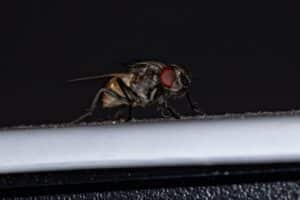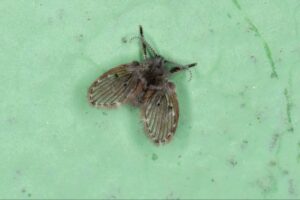Home / Blog / What Are Gnats Attracted To Outside?
What Are Gnats Attracted To Outside?

Scientifically reviewed by Rachel Maldonado
-Published on September 16, 2024
-Updated on December 3, 2025
What Attracts Gnats Outside?
Gnats. Those tiny, frustrating flying insects that always seem to find your face right when you’re about to relax on the patio. They may look harmless, but don’t underestimate them—just one female can lay up to 300 eggs in her short lifespan. That means a small presence can quickly turn into a buzzing cloud of annoying pests.
So, what attracts gnats to your yard in the first place? It’s a combination of dampness (perfect for breeding), moisture in potted plants & planters, the smell of food & drink, and, like moths, they’re naturally attracted to sources of light.
Let’s break down the most common attractants, explain how to make your yard less appealing to gnats, and share practical tips for both prevention and elimination.
Why Do Gnats Love Damp Spots?
Moisture is the number one draw for gnats. Standing water or damp areas create the perfect breeding grounds, whether it’s a puddle after rain or soil that never fully dries out. Even slightly overwatered potted plants can be enough to lure them in.
Common moisture sources that attract gnats include:
- Clogged gutters
- Leaky hoses or spigots
- Bird baths
- Poorly drained garden beds
- Kiddie pools left sitting after use
Regularly check for these moisture traps. Empty out your bird baths and small pools frequently, clear out gutters, and ensure your garden has proper drainage so there’s not a bunch of standing water around. For potted plants, avoid letting containers sit in trays of water. Simple maintenance goes a long way in cutting down on gnat breeding areas.
The Sweet Scent of Food and Trash
Like flies, gnats are notorious for loving sweets. They’re drawn to the smell of ripe fruits, rotting vegetables, sugary drinks, and food scraps. Hosting a barbecue or picnic? Be mindful of where you place food and drinks. Covering them can help deter the gnat party from getting started.
Trash is another hotspot. Garbage cans with food waste or recycling bins with sticky residue are prime gnat magnets. Compost piles can also be problematic if they aren’t properly sealed.
Here are some practical steps to prevent gnats from congregating:
- Keep outdoor trash bins tightly sealed
- Rinse containers before tossing them in recycling
- Use mesh food covers during gatherings
- Store compost in bins with secure lids
How Light Sources Attract Gnats
If you’ve noticed more gnats around outdoor lights, you’re not imagining it. Like moths, gnats are naturally drawn to light sources. Unfortunately, that means your porch light, garden path lighting, or even candles may be attracting them.
Incandescent bulbs are especially problematic because they emit wavelengths that are more attractive to insects. LED lights, on the other hand, are less appealing to gnats. Even small changes in lighting can help divert gnats away from where you want to relax.
Consider these adjustments to keep gnats away from your porch:
- Switch porch and patio lights to yellow-tinted “bug lights”
- Use motion-sensor or timed lights to minimize illumination
- Place lights further away from seating areas
What Plants Attract Gnats?
Unfortunately, plants can be another hidden culprit that draws gnats. While gnats don’t chew on leaves, they thrive in the damp soil of overwatered plants—that’s why you may see them in places like classrooms and offices. Some flowering plants, such as marigolds, may even unintentionally attract gnats despite their reputation for repelling other pests.
Check for signs of gnat activity around houseplants and garden beds. Soil that stays wet for too long is often the main issue. To discourage gnats, allow the soil to dry between waterings or top it with a layer of sand to make egg-laying more difficult. Also, introducing plants that repel gnats, such as lavender or rosemary, can help balance things out.
How to Get Rid of Gnats Outside
If gnats are already taking over, here are some simple steps to help get rid of gnats outside more effectively:
- Eliminate breeding grounds: Dry out soil, drain standing water, and repair leaks. If gnats can’t breed, they can’t hang around.
- Clean thoroughly: Empty food waste often, and tidy up outdoor eating areas. You should also rinse your trash cans and recycling bins during the warmer months.
- Set traps: DIY vinegar traps (a bowl with apple cider vinegar and a drop of dish soap) can capture gnats—and disposal is as easy as dumping out the bowl.
- Improve airflow: Gnats are tiny and struggle in windy environments, so using outdoor fans can discourage them from hanging around patios.
- Use professional treatments: Professional pest control may be necessary to target breeding sites you can’t easily access and provide long-term gnat prevention.
Take Back Your Yard with Hawx
Don’t let gnats ruin your time outdoors. While preventative measures can help, ongoing infestations often require professional attention.
At Hawx Pest Control, our experts specialize in identifying breeding grounds, treating problem areas, and helping you keep your outdoor space enjoyable all season long. We use a combination of local expertise, proven tools, and modern tech to root out pest control problems and prevent new ones from happening.
Contact Hawx today for a free estimate and reclaim your yard from gnats so you can enjoy your outdoors spaces without swarms of tiny bugs buzzing around.
Related Articles
Visit our blog to learn more.
→





